 Open Access
Open Access
ARTICLE
New Antenna Array Beamforming Techniques Based on Hybrid Convolution/Genetic Algorithm for 5G and Beyond Communications
1 Electronics and Communications Engineering Department, Higher Institute of Engineering and Technology, Kafr Elsheikh, Egypt
2 Electronics and Electrical Communications Engineering Department, Faculty of Engineering, Minia University, Minia, Egypt
3 Electronics and Electrical Communications Engineering Department, Faculty of Engineering, Tanta University, Tanta, Egypt
4 Electronics and Electrical Communications Engineering Department, Faculty of Engineering, Horus University Egypt, New Damietta, Egypt
5 Department of Computer Engineering, College of computer and Information Sciences, King Saud University, Riyadh, 11543, Saudi Arabia
6 School of Computing, Mathematics and Engineering, Charles Sturt University, Bathurst, NSW, 2795, Australia
* Corresponding Author: Hossam M. Kassem. Email:
(This article belongs to the Special Issue: Artificial Intelligence of Things (AIoT): Emerging Trends and Challenges)
Computer Modeling in Engineering & Sciences 2024, 138(3), 2749-2767. https://doi.org/10.32604/cmes.2023.029138
Received 03 February 2023; Accepted 25 July 2023; Issue published 15 December 2023
Abstract
Side lobe level reduction (SLL) of antenna arrays significantly enhances the signal-to-interference ratio and improves the quality of service (QOS) in recent and future wireless communication systems starting from 5G up to 7G. Furthermore, it improves the array gain and directivity, increasing the detection range and angular resolution of radar systems. This study proposes two highly efficient SLL reduction techniques. These techniques are based on the hybridization between either the single convolution or the double convolution algorithms and the genetic algorithm (GA) to develop the Conv/GA and DConv/GA, respectively. The convolution process determines the element’s excitations while the GA optimizes the element spacing. For elements linear antenna array (LAA), the convolution of the excitation coefficients vector by itself provides a new vector of excitations of length . This new vector is divided into three different sets of excitations including the odd excitations, even excitations, and middle excitations of lengths , , and , respectively. When the same element spacing as the original LAA is used, it is noticed that the odd and even excitations provide a much lower SLL than that of the LAA but with a much wider half-power beamwidth (HPBW). While the middle excitations give the same HPBW as the original LAA with a relatively higher SLL. To mitigate the increased HPBW of the odd and even excitations, the element spacing is optimized using the GA. Thereby, the synthesized arrays have the same HPBW as the original LAA with a two-fold reduction in the SLL. Furthermore, for extreme SLL reduction, the DConv/GA is introduced. In this technique, the same procedure of the aforementioned Conv/GA technique is performed on the resultant even and odd excitation vectors. It provides a relatively wider HPBW than the original LAA with about quad-fold reduction in the SLL.Keywords
The synthesis of antenna arrays has become an important study now, as it has many applications in the fields of communications, radar, etc. Therefore, the requirement for an array with a directive beam and reduced SLL prompted the search for promising antenna array synthesis techniques. SLL reduction or cancellation can be achieved by adjusting the amplitude and phase of excitations while keeping the spacing between the elements as in conventional arrays. They can also be accomplished by adjusting the spacing between antenna elements while keeping the excitation’s amplitude and phase. This is beneficial for avoiding interfering and undesired signals. There are two ways to improve the synthesis of antenna array patterns, the deterministic method, and the stochastic method [1]. The deterministic method is divided into analytical and semi-analytical methods. The deterministic method is characterized by the fact that the total calculation time for the synthesis process is very low, which makes it very suitable for real-time applications that distinguish it from the stochastic method. On the other hand, the stochastic method is known for its expensive calculations. However, it is more efficient and flexible than the deterministic method. In recent years, many algorithms have been developed to solve the synthesis problems of antenna arrays. A new mathematical formula of the array factor of linear antenna array was introduced in [2] to improve its performance in terms of directivity and SLL. It is based on the principle of mixing or hybridizing two different linear arrays and the resultant array is treated as a new linear array to fulfill the required purposes. The simulations revealed that the suggested formula outperformed the Chebyshev array that has the same number of antenna elements in terms of SLL, excitation coefficients, and directivity. The radiation pattern of non-uniform LAA is improved iteratively to obtain the optimum radiation pattern using a reduced number of elements and achieve SLL lower than
Newly proposed hybrid beamforming techniques for minimizing the size of uniform planar antenna arrays (UPAA) and reducing their SLL were presented in [14]. They are based on the hybridization between the two-dimensional (2D) convolution and GA. The SLL reduction is performed by controlling both the elements’ excitations and separation. The differential evolutionary (DE) algorithm was used in [15] to introduce a new approach for reducing SLL and rejecting interference signals in concentric hexagonal antenna arrays (CHAA). In the proposed approach, the CHAA was chosen because it would offer a lower SLL compared to circular and linear antenna arrays, which is considered a drawback of the approach.
In [16], the Eisenstein fractile array was presented to use the special geometrical characteristics of fractiles that permit multiband and wideband operation and prevent the appearance of grating lobes. In order to reduce the high SLL experienced at large-scale arrays, the proposed antenna array was thinned using the GA optimization technique. This was done by identifying the optimal set of “on” and “off” antenna elements that correspond to the minimum SLL without sacrificing the directivity of the array radiation pattern.
In [17], new hybrid array beamforming techniques based on the integration between the virtual antenna array (VAA) concept, PSO technique, and hyper-beamforming were introduced for SLL reduction and thinning of elliptical cylindrical antenna arrays (ECAA) in radar systems. The VAA decomposes the ECAA into created LAA and EAA. The number of antenna elements, element spacing, and excitations of the created LAA and EAA are optimized using PSO to produce efficient patterns with low SLL. Additional SLL reductions were achieved by using hyper-beamforming. In [18], new low SLL wideband planar antenna array designs based on the space-filling curves technique were presented. These arrays’ special geometrical properties are used to provide wideband operation and prevent the emergence of grating lobes. Wideband operation, SLL reduction, and grating lobe removal are only a few of the advantages of the newly proposed array designs over their traditional periodic planar array equivalents in terms of the radiation pattern. In [19], a new structure for a 1 × 8 slotted S-band waveguide array with non-uniform offset slot locations was proposed for SLL reduction. The slots on the upper metallic wall of the waveguide are distributed following a binomial distribution. The simulations revealed that the proposed array provided significantly reduced SLL compared to the slot array with a uniform offset location. In [20], a hybrid beamforming technique based on the combination of the genetic algorithm and the Gauss elimination algorithm denoted as GA/GE has been introduced for a specific side lobe cancellation of LAAs that reduces the received interference in the appropriate directions, which improves the receiver sensitivity. However, the GA/GE did not result in a general decrease in SLL. The performance of upcoming 5G cellular networks that utilize the mm-wave spectrum could be greatly improved by employing SLL reduction, which is considered one of the most crucial array beamforming techniques. The use of effective beamforming techniques such as SLL reduction and beam steering for antenna arrays at mobile base stations has several advantages, including longer battery life, a lower probability of an outage, much higher bit rates across a larger coverage area, lower infrastructure costs, and a higher capacity for numerous simultaneous users in both licensed and unlicensed spectrums. Due to its substantial unlicensed capacity, mm-wave communication is viewed as a key player for 5G and subsequent networks. There are significant difficulties, though, such as penetration and propagation losses. Antenna array beamforming is used to solve these problems as introduced in [21,22]. In [23], a highly efficient approach to improve the performance of multi-antenna elements-based spectrum sensing (SS) techniques in cognitive radio (CR) systems using SLL reduction has been introduced. It significantly improved the probability of detection of the CR system at much lower signal-to-noise ratio and signal-to-interference ratio scenarios. Furthermore, it improved the SS capability of the CR system further than SS based on array beamforming for maximum gain realization introduced in [24] and SS without array beamforming introduced in [25].
In this paper, two highly efficient SLL reduction techniques based on the hybrid combination between the convolution algorithms (single convolution algorithm (Conv) and the double convolution algorithm (DConv)) and the GA denoted as Conv/GA and DConv/GA, respectively, are proposed. In the Conv/GA technique, the convolution between the array excitation vector of length
The rest of the paper is organized as follows: Section 2 presents the related work. In Section 3, the proposed Conv/GA and DConv/GA beamforming techniques are introduced. Section 4 introduces the simulation results and discussions. Finally, the conclusion is presented in Section 5.
The following is a summary of the contributions provided by this paper:
1. The convolution approach has been employed in a unique way to synthesize LAAs using the proposed Conv/GA technique, achieving the same HPBW as the original LAA pattern while reducing the SLL by two-fold.
2. When applying the proposed DC/GA technique to LAAs, the SLL can be reduced by a quad-fold with minimal changes in the HPBW. This is beneficial for avoiding interfering, jamming, and unwanted signals.
3. When applying the proposed Conv/GA technique, the uniform linear antenna array (ULAA) and Chebyshev array synthesis using middle excitations provided a slightly higher SLL than the original arrays but with a much narrower HPBW. This main beam thinning effectively minimizes multipath signals and makes it suitable for positioning systems to increase location accuracy in 5G and beyond communications. Additionally, the outer antenna elements of the synthesized arrays can be turned off in order to execute array thinning. However, this array thinning causes the synthesized arrays’ SLL and HPBW to increase. Nevertheless, by adjusting the element spacing, the HPBW can be readjusted.
2 Linear Antenna Array Geometry and Genetic Algorithm
This section explains the geometrical construction of the linear antenna array (LAA) and the GA optimization technique while highlighting their key variables and parameters. Firstly, the GA is one of the most commonly used population-based metaheuristics optimization techniques that employ multiple candidate solutions during the search process. These metaheuristics preserve diversity in the population and avoid stuck solutions in the local optima. The GA is an optimization algorithm inspired by natural selection, which uses the concept of survival of the fit test [26]. New populations are produced through the frequent use of genetic operators over the existing individuals in the population. The major components of GA are the chromosome representation, selection, crossover, mutation, and computation of fitness functions. The GA procedure started by random initialization of a population
where
Secondly, the geometrical structure of the LAA is described considering an LAA consisting of
where

Figure 1: Structure of linear antenna array
3 Proposed Conv/GA and DConv/GA Beamforming Techniques
In this section, two proposed highly efficient SLL reduction techniques based on the hybrid combination between the convolution algorithms (single convolution algorithm (Conv) and the double convolution algorithm (DConv)) and the genetic algorithm (GA) denoted as Conv/GA and DConv/GA, respectively, are introduced. The convolution process determines the element’s excitations while the GA optimizes the element spacing.
In general, it is widely understood from Mathematical theory that the convolution of two sequences of lengths
where
Accordingly,
3.1 Proposed Conv/GA Technique
In this section, the proposed Conv/GA beamforming technique is introduced. It is based on calculating the convolution of the vector of excitations
where
The resultant vector
where
where
3.2 Proposed DConv/GA Technique
In this section, the proposed DConv/GA beamforming technique is introduced. It is based on calculating the convolution of the two aforementioned excitation vectors
where
The vector
In this case, the two synthesized patterns are calculated by:
While the vector
In this case, the two synthesized patterns are calculated by:
Also, to mitigate the HPBW problem, GA optimization is used for beam thinning of the synthesized arrays by determining the optimum element spacing

Figure 2: The flow chart that explains the proposed Conv/GA and DConv/GA algorithms
In this section, the simulation results of the proposed Conv/GA and DConv/GA beamforming techniques are introduced for SLL reduction of non-uniform Chebyshev arrays and uniform linear antenna arrays.
Test Case 1: SLL Reduction of Odd Chebyshev Array Using Convolution Method
Consider a broadside Chebyshev array with odd number of elements

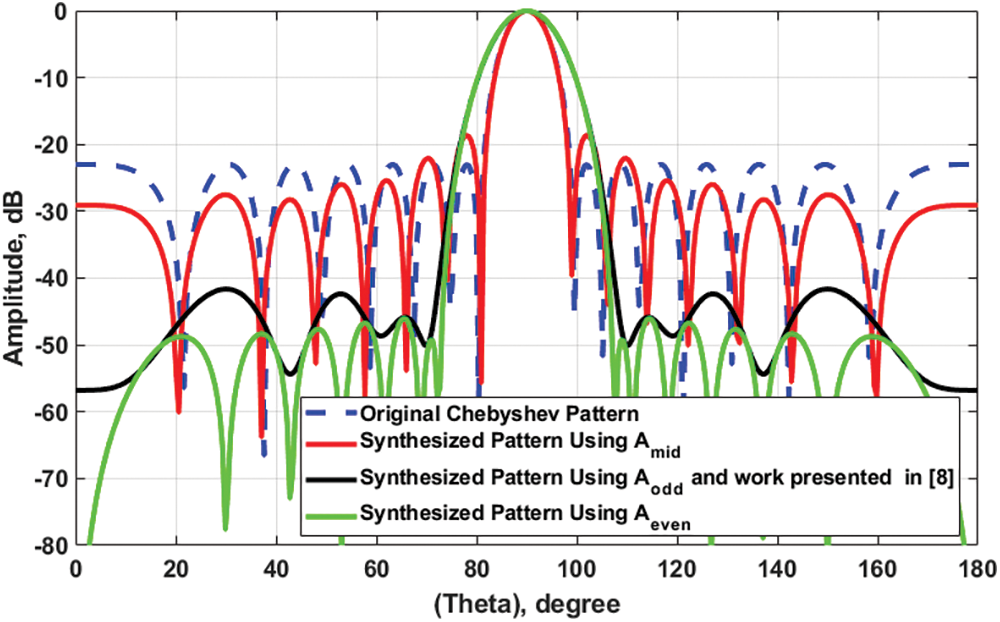
Figure 3: Synthesized array patterns using convolution method compared with the original Chebyshev pattern for

Test Case 2: SLL Reduction of Odd Chebyshev Array Using the Proposed Conv/GA Technique
In this case, the HPBW problem that occurred in the test case (1) is mitigated by using the proposed Conv/GA technique where the element spacing is optimized to minimize the designed cost function in Eq. (9). Fig. 4 shows the synthesized patterns using the odd, even, and middle excitation coefficients with optimized element spacing
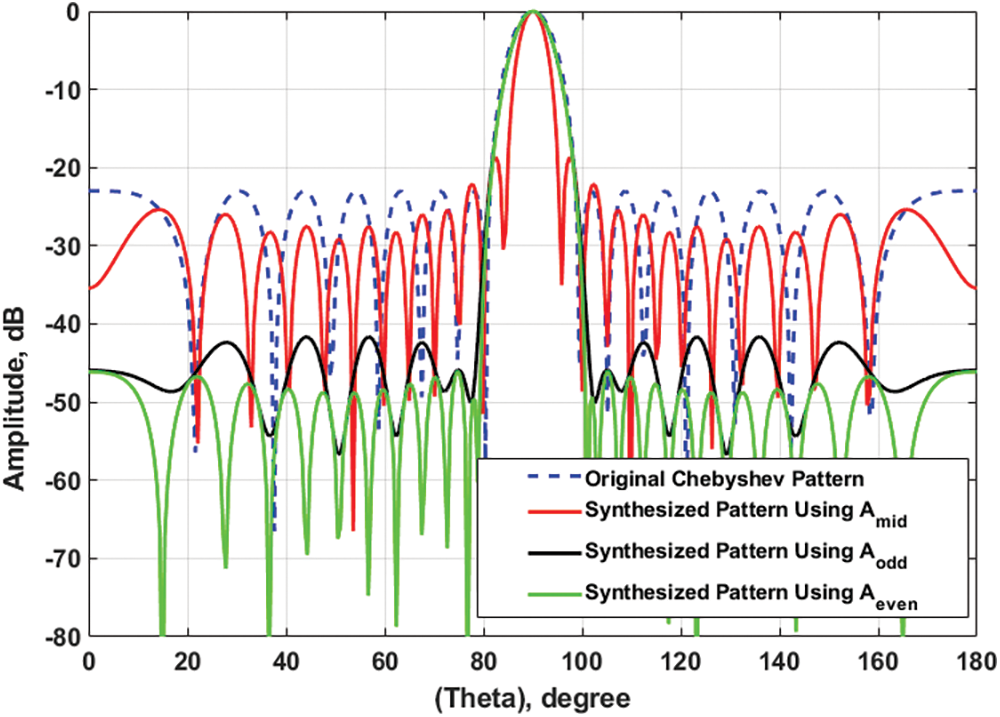
Figure 4: Synthesized array patterns using the proposed Conv/GA compared with the original Chebyshev pattern for

Test Case 3: SLL Reduction of Even Chebyshev Array Using Convolution Method
Consider a broadside Chebyshev array with even number of elements

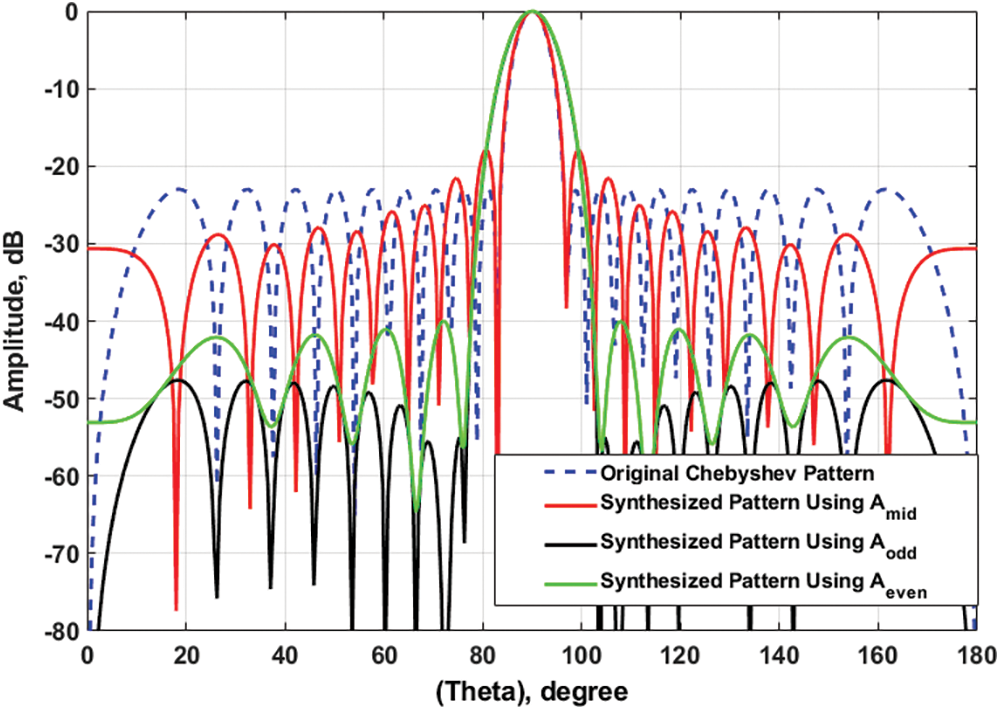
Figure 5: Synthesized array patterns using convolution method compared with the original Chebyshev pattern for

Test Case 4: SLL Reduction of Even Chebyshev Array Using the Proposed Conv/GA Technique
By applying the Conv/GA, the optimized element spacing is found to be
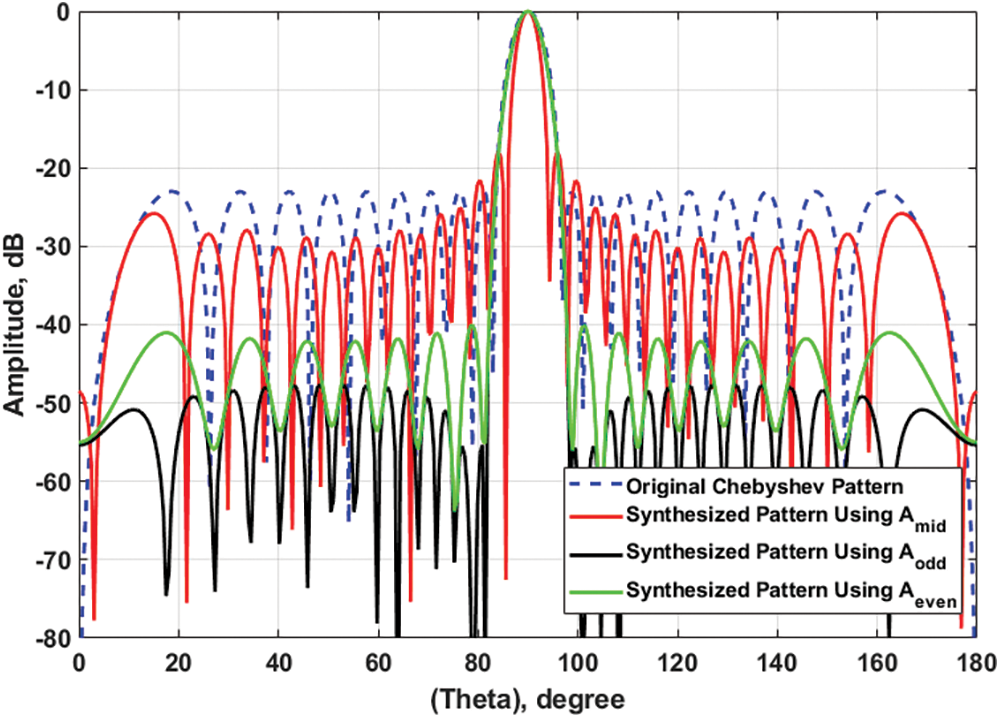
Figure 6: Synthesized array patterns using the proposed Conv/GA compared with the traditional Chebyshev pattern for

Test Case 5: SLL Reduction of Chebyshev Array Using the Proposed DConv/GA Technique and
In this section, the proposed DConv/GA technique is applied to the odd excitation vector

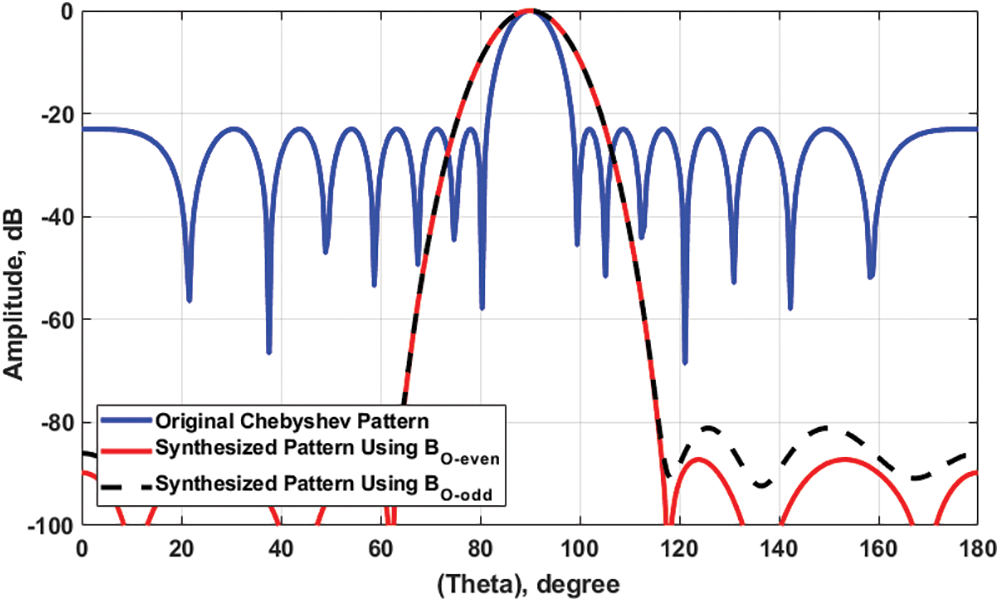
Figure 7: The synthesized arrays patterns using

Test Case 6: SLL Reduction of Chebyshev Array Using the Proposed DConv/GA Technique and
In this section, the proposed DConv/GA technique is applied to the even excitation vector

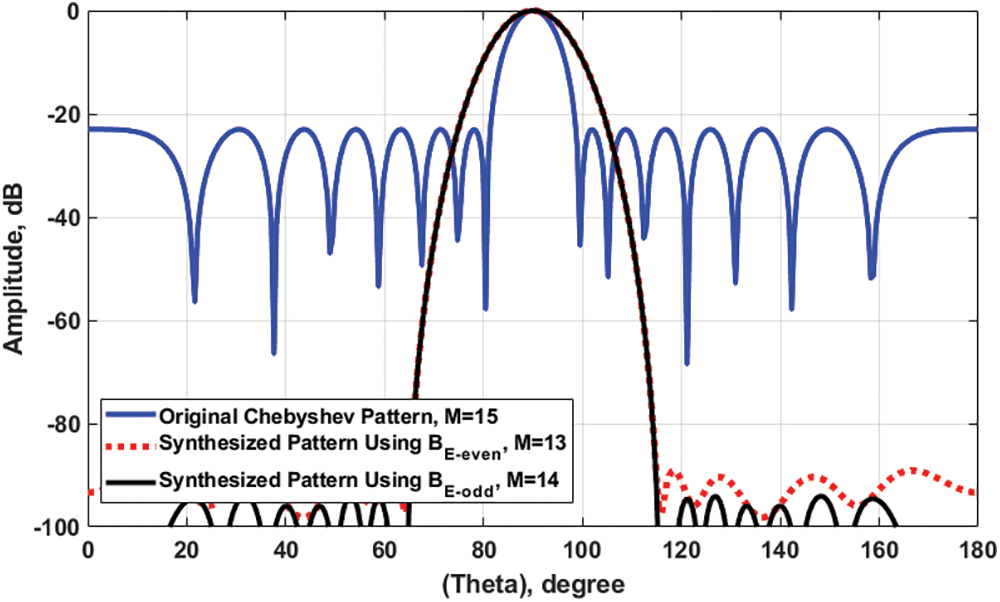
Figure 8: The synthesized arrays patterns using

Test Case 7: SLL Reduction of Uniform Linear Antenna Array Using the Proposed Conv/GA Technique
In this section, the proposed Conv/GA technique is used to synthesis a uniform linear antenna array (ULAA) consisting of
By taking the convolution of the excitation coefficient vector

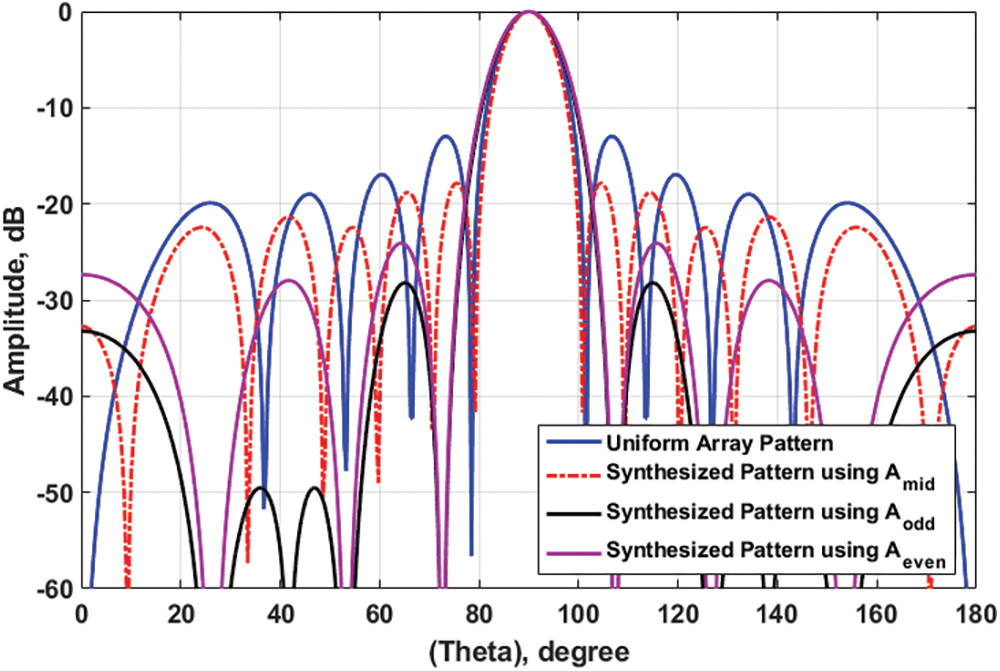
Figure 9: Synthesized array patterns using the proposed Conv/GA technique compared with the original uniform array pattern for

In this paper, simple and highly effective SLL reduction techniques for LAAs denoted as Conv/GA and DConv/GA are introduced. The convolution method is used to determine the element’s excitations that minimize the array SLL. GA is used to determine the optimum spacing between the elements, which guarantees the same HPBW as the original array in the case of the Conv/GA technique and guarantees the least change in HPBW in the case of the DConv/GA technique. For Chebyshev array consisting of an odd number of elements, the even excitation vector provides the lowest SLL that is two times lower than that of the original array and saves the number of elements by one element. While for LAA consisting of an even number of elements, the odd excitation vector provides the lowest SLL which is 2.076 times lower than that of the original array using the same number of elements. On the other hand, the DConv/GA provided about 4 times reduction in the SLL compared to the original array SLL with minimal changes in the HPBW of the main beam and saves one or two antenna elements according to the selected coefficients. In the case of the uniform antenna array, the proposed Conv/GA technique provides much lower SLL than the original array pattern using the synthesized middle, even, and odd excitations. It is evident that the proposed algorithms reduced the SLL by two fixed and distinct amounts for any type of linear antenna array, whether ULAA or Chebyshev array, which are two-fold, or quad-fold reduction compared to the original SLL.
Acknowledgement: The authors would like to thank the King Saud University, Saudi Arabia for supporting this work.
Funding Statement: This research is funded by Research Supporting Project Number (RSPD2023R585), King Saud University, Riyadh, Saudi Arabia.
Author Contributions: Shimaa M. Amer, Ashraf A. M. Khalaf, Amr H. Hussein, Salman A. Alqahtani, Mostafa H. Dahshan, and Hossam M. Kassem are contributed equally in study conception and design, data collection, analysis and interpretation of results, reviewed the results and approved the final version of the manuscript.
Availability of Data and Materials: All the readers can contact Dr. Amr H. Hussein for any future inquiries.
Conflicts of Interest: The authors declare that they have no conflicts of interest to report regarding.
References
1. Buttazzoni, G., Babich, F., Vatta, F., Comisso, M. (2019). Comparison between deterministic and stochastic methods for the synthesis of aperiodic arrays. 2019 IEEE International Symposium on Antennas and Propagation and USNC-URSI Radio Science Meeting, pp. 51–52. Atlanta, GA, USA, IEEE. [Google Scholar]
2. Gassab, O., Azrar, A. (2016). Novel mathematical formulation of the antenna array factor for side lobe level reduction. The Applied Computational Electromagnetics Society Journal (ACES), 31(12), 1452–1462. [Google Scholar]
3. Todnatee, S., Phongcharoenpanich, C. (2016). Iterative GA optimization scheme for synthesis of radiation pattern of linear array antenna. International Journal of Antennas and Propagation, 2016, 1–8. [Google Scholar]
4. Saxena, P., Kothari, A. (2016). Ant lion optimization algorithm to control side lobe level and null depths in linear antenna arrays. AEU-International Journal of Electronics and Communications, 70(9), 1339–1349. [Google Scholar]
5. Prerna, S., Kothari, A. (2016). Optimal pattern synthesis of linear antenna array using grey wolf optimization algorithm. International Journal of Antennas and Propagation, 2016, 1–11. [Google Scholar]
6. Žarko, R., Mihić, O. (2016). Linear antenna array synthesis with minimum side lobe level and null controling. Revue Roumaine des Sciences Techniques, Série Électrotechnique et Énergétique, 61(4), 414– 417. [Google Scholar]
7. Ankur, T., Talluri Raju, S. (2017). A novel pulse compression technique for side-lobe reduction using woo filter concepts. International Conference on Communication and Signal Processing (IEEE), pp. 1086–1090. Chennai, India. [Google Scholar]
8. Alijani, M. G. H., Neshati, M., Boozari, M. (2017). Side lobe level reduction of any type of linear equally spaced array using the method of convolution. Progress in Electromagnetics Research Letters, 66, 79–84. [Google Scholar]
9. Santos, F. E. S., Azevedo, J. A. R. (2017). Adapted raised cosine window function for array factor control with dynamic range ratio limitation. 11th European Conference on Antennas and Propagation (EUCAP), pp. 2020–2024. Paris, France, IEEE. [Google Scholar]
10. Geng, S., Liu, Y., Han, L., Liang, S., Wang, A. et al. (2018). An antenna array sidelobe level reduction approach through invasive weed optimization. Hindawi International Journal of Antennas and Propagation, 2018, 1–16. [Google Scholar]
11. Zhang C., Fu X., Ligthart L. P., Peng S., Xie M. (2018). Synthesis of broadside linear aperiodic arrays with sidelobe suppression and null steering using whale optimization algorithm. IEEE Antennas and Wireless Propagation Letters, 17(2), 347–350. [Google Scholar]
12. AdithyaValli, N., Elizabath Rani, D., Kavitha, C. (2019). Convolution windows for side lobe reduction. International Journal of Innovative Technology and Exploring Engineering (IJITEE), 8(10), 3526–3529. [Google Scholar]
13. Károly, M., Kracek, J., Bilicz, S. (2020). Antenna array pattern synthesis using an iterative method. IEEE Transactions on Magnetics, 56(2), 1–4. [Google Scholar]
14. Elkhawaga, A. M., Mahmoud, N. M., Abd Elnaby, M. M., Hussein, A. H. (2022). New hybrid approaches for SLL reduction and size miniaturization of planar antenna arrays based on 2D convolution and genetic algorithm. Alexandria Engineering Journal, 61(9), 7233–7264. [Google Scholar]
15. Akhitha, K., Ram, G. (2022). Side lobe reduction and interference rejection in concentric hexagonal antenna array using differential evolutionary algorithm. 2022 IEEE Microwaves, Antennas, and Propagation Conference (MAPCON), pp. 681–685. Bangalore, India. [Google Scholar]
16. El-Khamy, S. E., El-Sayed, H. F., Eltrass, A. S. (2022). Synthesis of wideband thinned eisenstein fractile antenna arrays with adaptive beamforming capability and reduced side-lobes. IEEE Access, 10, 122486–122500. [Google Scholar]
17. Dawood, H., El-Khobby, H., Abd Elnaby, M. M., Hussein, A. (2021). Optimized VAA based synthesis of elliptical cylindrical antenna array for SLL reduction and beam thinning using minimum number of elements. IEEE Access, 9, 50949–50960. [Google Scholar]
18. El-Khamy, S., El-Sayed, H. F., Eltrass, A. (2023). New wideband antenna arrays with low sidelobe based on space filling curves. 2023 International Microwave and Antenna Symposium (IMAS), pp. 56–61. Cairo, Egypt. [Google Scholar]
19. Dipankar, S., Saha, C., Siddiqui, J. Y. (2022). Binomially distributed slotted array antenna with highly reduced sidelobe level. 2022 IEEE 19th India Council International Conference (INDICON), pp. 1–3. Kochi, India, 2022 [Google Scholar]
20. Abdelrahman, S. I., Hussein, A. H., Shaalan, A. E. A. (2021). A hybrid GA/GE beamforming technique for side lobe cancellation of linear antenna arrays. Advanced Electromagnetics, 10(2), 67–77. [Google Scholar]
21. Theodore, S. R., Sun, S., Mayzus, R., Zhao, H., Azar, Y. et al. (2013). Millimeter wave mobile communications for 5G cellular: It will work!. IEEE Access, 1, 335–349. [Google Scholar]
22. Nor, A. M., Halunga, S., Fratu, O. (2022). Survey on positioning information assisted mmWave beamforming training. Ad Hoc Networks, 135(9), 102947. https://doi.org/10.1016/j.adhoc.2022.102947 [Google Scholar] [CrossRef]
23. Hager, S. F., Nasr, M. E., Hussein, A. H. (2022). A highly efficient approach for performance enhancement of multiple antenna elements based spectrum sensing techniques using side lobe level reduction. Alexandria Engineering Journal AEJ, 61(8), 5983–5999. [Google Scholar]
24. Hussein, A., Shawky Fouda, H., Hussein Abdullah, H., Khalaf, A. A. M. (2020). A highly efficient spectrum sensing approach based on antenna arrays beamforming. IEEE Access, 8, 25184–25197. [Google Scholar]
25. Ahmed, A. K., Hussein, A. H., Khalaf, A. A. M., Hamed, H. F. A. (2019). A utilization of multiple antenna elements for matched filter based spectrum sensing performance enhancement in cognitive radio system. AEU-International Journal of Electronics and Communications, 107, 98–109. [Google Scholar]
26. Katoch, S., Chauhan, S. S., Kumar, V. (2021). A review on genetic algorithm: Past, present, and future. Multimedia Tools and Applications, 80(5), 8091–8126. [Google Scholar] [PubMed]
Cite This Article
 Copyright © 2024 The Author(s). Published by Tech Science Press.
Copyright © 2024 The Author(s). Published by Tech Science Press.This work is licensed under a Creative Commons Attribution 4.0 International License , which permits unrestricted use, distribution, and reproduction in any medium, provided the original work is properly cited.


 Submit a Paper
Submit a Paper Propose a Special lssue
Propose a Special lssue View Full Text
View Full Text Download PDF
Download PDF Downloads
Downloads
 Citation Tools
Citation Tools